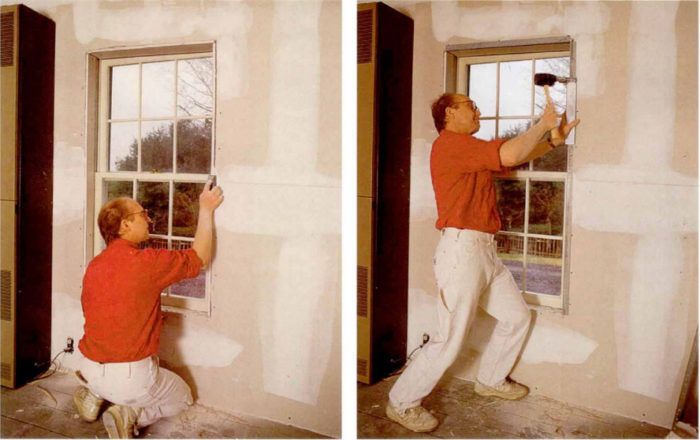
Synopsis: A drywall specialist demonstrates how corner bead and drywall can replace wood trim at door and window openings. Drywall is a low-cost alternative to expensive stain-grade trim and more attractive than the inexpensive pine that may be used in its place.
Trimming out doors, windows and skylights can be a rewarding endeavor. It can also be costly, if done with the proper care and materials that this labor-intensive procedure requires. Unfortunately, as a house nears completion and costs are running over estimate, this can be one area of a job that experiences severe cutbacks. The most frequently used alternative to first-rate trim is inexpensive pine, applied as plainly as possible. Many owner-builders, and even some contractors, justify this route with the argument that one can go back through the house when time and money allow, and redo the trim in proper fashion. Of course, we all know that the chances of this happening are slim.
A more graceful alternative to the pine solution is drywall detailing around windows, sky-lights, archways, and even doors. Although the labor involved is comparable to that for installing wood trim, the materials are much less expensive. Don’t get me wrong—I love beautiful trim work. But I also appreciate a project brought in on budget. And even where money isn’t the overriding factor, drywall detailing may still be the most effective and pleasing solution to many trim problems. This is particularly true in renovation, where old work must abut new.
Mud and metal
The basic materials for detailing wall openings are the various beads, moldings and tapes that are available through a good drywall supplier. I have not used the blueboard and veneer-coat system of plaster, so here I’ll concentrate on the standard dry-wall accessories.
Corner bead is the obvious choice for forming wall returns into windows, without the use of casings. It’s available in galvanized steel and white vinyl. Corner bead can be attached by driving a drywall nail every 4 in. to 6 in. along each side of its length. The length of the nail will depend on the thickness of the drywall; the nail should penetrate the framing 3/8 in. to 1/2 in. One advantage of metal corner bead is that you can attach it with a crimping tool,which crimps the edges of the bead so that it grips the drywall. This saves quite a bit of time, especially on large jobs, and also helps to center the bead. If the bead is rolled to one side, it makes the other side difficult to cover with compound. Though I use a crimping tool to set the bead, I always add four to six nails for extra security. Any structural movement, particularly in a new house, is liable to show around windows and doors, and the first casualty will always be the drywall work. But there are times when nails can’t be used, particularly in old houses where the interior walls have been covered with a layer of foamboard insulation beneath new drywall. The foam and drywall create built-up corners through which nails won’t easily reach. In such cases, a crimping tool is all one can use in applying standard metal corner bead. Crimping tools retail for $60 to$70.
For more photos and information about detailing with drywall, click the View PDF button below.
Fine Homebuilding Recommended Products
Fine Homebuilding receives a commission for items purchased through links on this site, including Amazon Associates and other affiliate advertising programs.

Smart String Line

Original Speed Square

100-ft. Tape Measure

























